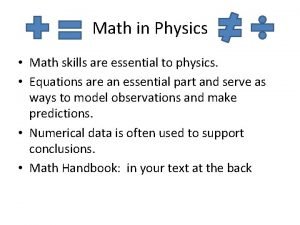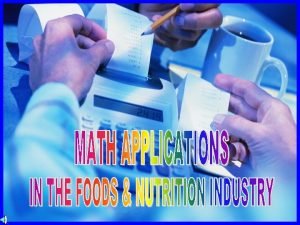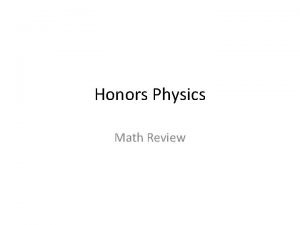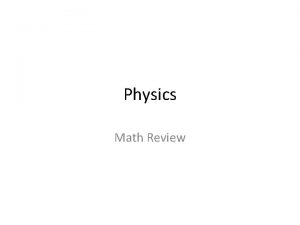Math in Physics Math skills are essential to










- Slides: 10

Math in Physics • Math skills are essential to physics. • Equations are an essential part and serve as ways to model observations and make predictions. • Numerical data is often used to support conclusions. • Math Handbook: in your text at the back

Units, Units… • System International d’Unites (SI) or the adapted version known as the metric system is used in science. • 7 base units (from direct measurement) • Additional units are derived from the seven base units (combinations of base units) • Example: mass and volume can be measured directly using a balance and graduated cylinder. Density however is a derived unit obtained from the relationship between mass and volume D=m/v

SI Base Units Base Quantity Unit of measure abbreviation Time Second sec Mass Kilogram kg Length Meter m Temperature Kelvin K Amount of substance Mole mol Electric current Ampere A Luminous intensity Candela cd (chart courtesy of Glencoe Physics: Principles and Problems, Zitzewitz, et. al. 2005, Mc. Graw-Hill, New York)

Prefixes Used with SI units. . (chart courtesy of Glencoe Physics: Principles and Problems, Zitzewitz, et. al. 2005, Mc. Graw-Hill, New York) Prefix Symbol Multiplier Scientific Notation example femto- f 0. 00000001 10 -15 femtosecond pico- p 0. 0000001 10 -12 picometer nano- n 0. 00001 10 -9 nanometer micro- μ 0. 000001 10 -6 microgram milli- m 0. 001 10 -3 milliamps centi- c 0. 01 10 -2 centimeter deci- d 0. 1 10 -1 deciliter kilo- k 1000 103 kilometer mega- M 1000000 106 megagram giga- G 100000 109 gigameter tera- T 1000000 1012 terahertz

Conversions and Conversion Factors • Using dimensional analysis allows you to treat units as algebraic quantities which can be cancelled. • Steps: – Write out given quantity. – Decide what units the final answer needs. – Choose a conversion factor that allows you to cancel the units given using multiplication and/or division and leave units desired for final answer.

Try it…. . 1. Convert 5021 centimeters to kilometers? 2. How many seconds are in a leap year? 3. Convert the speed 5. 30 m/s to km/hr.

Scientific Notation • Used to express large numbers • Makes working with large numbers easier • To convert a number to scientific notation – Move decimal so that there is one non-zero digit to the left of the decimal – Ex. 3000000 3. 000000 then add x 10 and the exponent that represents how many spaces that the decimal was moved – 3. 000000 x 106

• To convert a number from scientific notation to regular notation • Move the decimal left (for a negative exponent) and right (for a positive exponent) the number of spaces as indicated by the exponent • Example: 2. 36 x 10 -3 would be 0. 00236 2. 25 x 102 would be 225

Collecting Data, Making Measurements • • Accuracy Precision Technique Variables

Creating Graphs for Representing data • Linear • Non-linear • Inverse relationships
 Antigentest åre
Antigentest åre Skills passport
Skills passport Physics math skills worksheet answers
Physics math skills worksheet answers Plamatic acid
Plamatic acid 9 essential skills for the love and logic classroom
9 essential skills for the love and logic classroom Oxford essential hkdse practice papers set 1 answer
Oxford essential hkdse practice papers set 1 answer Skills that are essential to self-employment success
Skills that are essential to self-employment success Essential skills to study geography
Essential skills to study geography 7 essential skills for teamwork
7 essential skills for teamwork Amwa essential skills certificate
Amwa essential skills certificate Math is not an essential skill for foodservice managers.
Math is not an essential skill for foodservice managers.



















